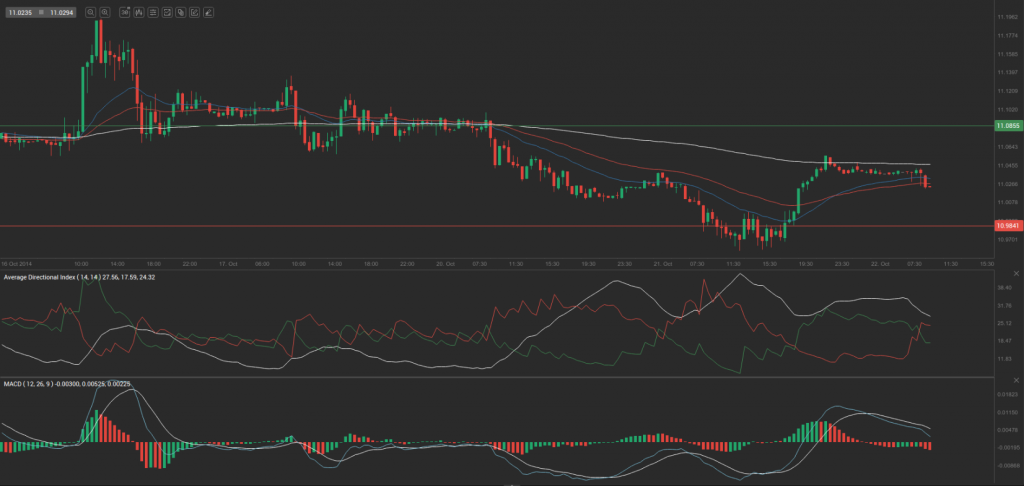Yesterday’s trade saw USD/ZAR within the range of 10.9580-11.0594. The pair closed at 11.0478, gaining 0.26% on a daily basis.
At 6:58 GMT today USD/ZAR was down 0.18% for the day to trade at 11.0272. The pair touched a daily low at 11.0250 at 6:57 GMT.
Fundamentals
United States
The annualized index of consumer prices (CPI) in the United States probably decelerated to 1.6% in September, according to market expectations, from 1.7% in August. If so, this would be the third consecutive month of slowdown. In monthly terms, the CPI probably remained flat in September, following a 0.2% drop in the prior month, which has been the first in 16 months. In August prices of food and shelter rose, but the increases were more than offset by a decline in energy prices. The latter dropped at an annualized rate of 2.6% in August, while gasoline prices alone declined 4.1%.
The CPI is based on a basket of goods and services bought and used by consumers on a daily basis. In the United States the Bureau of Labor Statistics (BLS) surveys the prices of 80 000 consumer items in order to calculate the index. The latter reflects prices of commonly purchased items by primarily urban households, which represent about 87% of the US population. The Bureau processes price data from 23 000 retail and service businesses.
The CPI includes sales taxes, but excludes income taxes, costs of investments such as stocks and bonds and sales prices of homes.
The annualized Core CPI, which excludes prices of food and energy, probably remained unchanged at 1.7% in September. It is usually reported as a seasonally adjusted figure, because consumer patterns are widely fluctuating in dependance on the time of the year. The Core CPI is a key measure, because this is the gauge, which the Federal Reserve Bank examines in order to adjust its monetary policy. The Fed uses the core CPI, because prices of food, oil and gas are highly volatile and central bank’s tools are slow-acting. In case, for example, prices of oil surge considerably, this could lead to a high rate of inflation, but the central bank will not take action until this increase affects prices of other goods and services.
If the CPI tends to approach or comes in line with the inflation objective, set by the Federal Reserve and considered as providing price stability, or 2%, this will usually support demand for the US dollar. However, quite high rates of inflation (well above central bank’s inflation target) can be harmful to economy and as a result, this may lead to the loss of confidence in the local currency.
The Bureau of Labor Statistics is to release the official CPI report at 12:30 GMT.
South Africa
The annualized consumer inflation in South Africa probably slowed down to 6.1% in September, according to the median estimate by experts, from 6.4% in August. Prices of food and non-alcoholic beverages were the main driver of inflation in August. They rose 0.8% between July and August, while the annual rate of increase was 9.4% in August, an acceleration from 8.8%, reported in July. Transport costs climbed 0.4% between July and August, while increasing at an anualized rate of 6.1% in August, which followed another 6.9% gain in July.
Key categories in South African Consumer Price Index (CPI) are Housing and Utilities (accounting for 24.5% of total weight), Transport (16.4%) and Food and Non-Alcoholic Beverages (15.4%). Others categories include Miscellaneous Goods and Services such as personal care, insurance and finance (14.7%), Alcoholic Beverages and Tobacco (5.4%), Household Contents, Equipment and Maintenance (4.8%), Recreation and culture (4.1%), Clothing and Footwear (also 4.1%). The remaining portion of the index is comprised by categories such as Restaurants and Hotels (3.5%), Education (3%), Communication (2.6%) and Health (1.5%).
The CPI measures the change in price levels of the above mentioned basket of goods and services from consumer’s perspective and also reflects purchasing tendencies. In case the CPI decelerated more than anticipated, this might have a bearish effect on the rand. Statistics South Africa is to release the official CPI report at 8:00 GMT.
Pivot Points
According to Binary Tribune’s daily analysis, the central pivot point for the pair is at 11.0217. In case USD/ZAR manages to breach the first resistance level at 11.0855, it will probably continue up to test 11.1231. In case the second key resistance is broken, the pair will probably attempt to advance to 11.1869.
If USD/ZAR manages to breach the first key support at 10.9841, it will probably continue to slide and test 10.9203. With this second key support broken, the movement to the downside will probably continue to 10.8827.
The mid-Pivot levels for today are as follows: M1 – 10.9015, M2 – 10.9522, M3 – 11.0029, M4 – 11.0536, M5 – 11.1043, M6 – 11.1550.
In weekly terms, the central pivot point is at 11.0826. The three key resistance levels are as follows: R1 – 11.2009, R2 – 11.3212, R3 – 11.4395. The three key support levels are: S1 – 10.9623, S2 – 10.8440, S3 – 10.7237.






